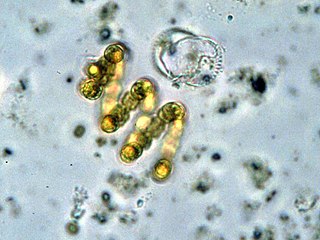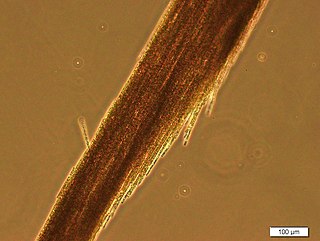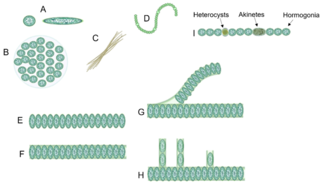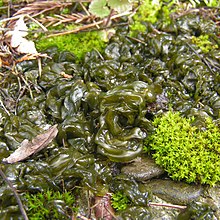
A cell wall is a structural layer surrounding some types of cells, just outside the cell membrane. It can be tough, flexible, and sometimes rigid. It provides the cell with both structural support and protection, and also acts as a filtering mechanism. Cell walls are absent in many eukaryotes, including animals, but are present in some other ones like fungi, algae and plants, and in most prokaryotes. A major function is to act as pressure vessels, preventing over-expansion of the cell when water enters.

Cyanobacteria, also called Cyanobacteriota or Cyanophyta, are a phylum of gram-negative bacteria that obtain energy via photosynthesis. The name cyanobacteria refers to their color, which similarly forms the basis of cyanobacteria's common name, blue-green algae, although they are not usually scientifically classified as algae. They appear to have originated in a freshwater or terrestrial environment. Sericytochromatia, the proposed name of the paraphyletic and most basal group, is the ancestor of both the non-photosynthetic group Melainabacteria and the photosynthetic cyanobacteria, also called Oxyphotobacteria.

Fat choy is a terrestrial cyanobacterium that is used as a vegetable in Chinese cuisine. When dried, the product has the appearance of black hair. For that reason, its name in Chinese means "hair vegetable". When soaked, fat choy has a soft texture which is like very fine vermicelli.

Anabaena is a genus of filamentous cyanobacteria that exist as plankton. They are known for nitrogen-fixing abilities, and they form symbiotic relationships with certain plants, such as the mosquito fern. They are one of four genera of cyanobacteria that produce neurotoxins, which are harmful to local wildlife, as well as farm animals and pets. Production of these neurotoxins is assumed to be an input into its symbiotic relationships, protecting the plant from grazing pressure.

Nostoc, also known as star jelly, troll's butter, spit of moon, fallen star, witch's butter, and witch's jelly, is the most common genus of cyanobacteria found in a variety of both aquatic and terrestrial environments that may form colonies composed of filaments of moniliform cells in a gelatinous sheath of polysaccharides. It may also grow symbiotically within the tissues of plants, providing nitrogen to its host through the action of terminally differentiated cells known as heterocysts. Nostoc is a genus that includes many species that are diverse in morphology, habitat distribution, and ecological function. Nostoc can be found in soil, on moist rocks, at the bottom of lakes and springs, and rarely in marine habitats. It may also be found in terrestrial temperate, desert, tropical, or polar environments.

Biological soil crusts are communities of living organisms on the soil surface in arid and semi-arid ecosystems. They are found throughout the world with varying species composition and cover depending on topography, soil characteristics, climate, plant community, microhabitats, and disturbance regimes. Biological soil crusts perform important ecological roles including carbon fixation, nitrogen fixation and soil stabilization; they alter soil albedo and water relations and affect germination and nutrient levels in vascular plants. They can be damaged by fire, recreational activity, grazing and other disturbances and can require long time periods to recover composition and function. Biological soil crusts are also known as biocrusts or as cryptogamic, microbiotic, microphytic, or cryptobiotic soils.

The Nostocaceae are a family of cyanobacteria that forms filament-shaped colonies enclosed in mucus or a gelatinous sheath. Some genera in this family are found primarily in fresh water, while others are found primarily in salt water. Other genera may be found in both fresh and salt water. Most benthic algae of the order Nostocales belong to this family.

Geosiphon is a genus of fungus in the family Geosiphonaceae. The genus is monotypic, containing the single species Geosiphon pyriformis, first described by Kützing in 1849 as Botrydium pyriforme. In 1915, Von Wettstein characterized Geosiphon pyriforme as a multinucleate alga containing endosymbiotic cyanobacteria, although he also noted the presence of chitin, a component of fungal cell walls. In 1933, Knapp was the first to suggest the fungal origin of the species and described it as a lichen with endosymbiotic cyanobacteria. It is the only member of the Glomeromycota known to not form a symbiosis with terrestrial plants in the form of arbuscular mycorrhiza.

Aphanizomenon is a genus of cyanobacteria that inhabits freshwater lakes and can cause dense blooms. They are unicellular organisms that consolidate into linear (non-branching) chains called trichomes. Parallel trichomes can then further unite into aggregates called rafts. Cyanobacteria such as Aphanizomenon are known for using photosynthesis to create energy and therefore use sunlight as their energy source. Aphanizomenon bacteria also play a big role in the Nitrogen cycle since they can perform nitrogen fixation. Studies on the species Aphanizomenon flos-aquae have shown that it can regulate buoyancy through light-induced changes in turgor pressure. It is also able to move by means of gliding, though the specific mechanism by which this is possible is not yet known.

Nostoc verrucosum is a species of cyanobacteria usually found in colonies and in globose racks. It has a greenish to blackish color. It grows in creek beds, shallow streams, waterfalls, and moist understory in rain forests, in alkaline soil and water habitat. Colonies are velvety to the touch.

Gelidium amansii, also known as umutgasari, is an economically important species of red algae commonly found and harvested in the shallow coast of many East Asian countries including North and South Korea, China, Japan, Singapore, and northeast Taiwan. G. amansii is an important food source in East Asian countries and has been shown to have medicinal effects on dieting. Hence, in folklore medicine G. amansii is used to treat constipation. This algae is used to make agar, whose components are the polysaccharide agarose and agaropectin, from the large amount of algin which is located in the algae's cell wall, as well it is sometimes served as part of a salad, puddings, jams, and other culinary dishes in producing regions. Agar is a gelatinous substance that is commercially used both as an ingredient in gelatinous desserts and as an incubation matrix for microbes and other products that require an ecologically friendly gelatinous matrix. G. amansii can be purple, red, to yellowish-red because it contains the class of pigments known as phycobiliprotein. Its branching body is cartilaginous and can grow up to a height of 8 to 30 cm or 3 to 12 in. G. amansii may have four or five opposite, compound-lobed, pinnate leaves on each branch. It is uniaxial with an apical cell and whorled cells coming from the axial towards the exterior of the algae. The pith is compacted with apical cells and the epidermis is formed by rounded whorled cells. G. amansii is being studied as a cheap biofuel.
Mycosporine-like amino acids (MAAs) are small secondary metabolites produced by organisms that live in environments with high volumes of sunlight, usually marine environments. The exact number of compounds within this class of natural products is yet to be determined, since they have only relatively recently been discovered and novel molecular species are constantly being discovered; however, to date their number is around 30. They are commonly described as “microbial sunscreens” although their function is believed not to be limited to sun protection. MAAs represent high potential in cosmetics, and biotechnological applications. Indeed, their UV-absorbing properties would allow to create products derived from natural photoprotectors, potentially harmless to the environment and efficient against UV damage.
Bangia is an extant genus of division Rhodophyta that grows in marine or freshwater habitats. Bangia has small thalli with rapid growth and high reproductive output, and exhibits behavior characteristic of r-selected species. The plants are attached by down-growing rhizoids, usually in dense purple-black to rust-colored clumps. The chloroplasts of Bangia, like others in the division Rhodophyta, contain chlorophyll a and sometimes chlorophyll d, as well as accessory pigments such as phycobilin pigments and xanthophylls. Depending on the relative proportions of these pigments and the light conditions, the overall color of the plant can range from green to red to purple to grey; however, the red pigment, phycoerythrin, is usually dominant.
Radaisia is a genus of coccoid cyanobacterium comprising about 10 identified species. It is a colonial cyanobacterium, the bacteria initially forming a round to irregularly shaped flat group of gelatinous or crustose cells attached to the substrate from which arise rows of pseudofilamentous cells in mucilaginous sheaths perpendicular to the initial colony. Apical cells of the pseodofilamentous sheaths are elongate compared to proximal cells in the sheath. Cell division in the genus is notably irregular, although usually perpendicular to the axis in the pseudofilament. The cells are light blue-green to reddish purple in color.
Raphidiopsis raciborskii is a freshwater cyanobacterium.)

Collema tenax is a species of lichen known by the common names jelly lichen, black lichen, and desert lichen. It occurs in Arctic and temperate regions in the Northern Hemisphere. It is very common in North America, and it is present in Europe, Asia, and Africa. It is the most widely distributed Collema.
Crinalium epipsammum is a filamentous, non-heterocystous, terrestrial cyanobacterium. The species is highly drought-resistant and was first identified from its role in forming crusts on coastal sand dunes in the Netherlands.

Rivularia is a genus of cyanobacteria of the family Rivulariaceae.

Cyanothece is a genus of unicellular, diazotrophic, oxygenic photosynthesizing cyanobacteria.

Cyanobacterial morphology refers to the form or shape of cyanobacteria. Cyanobacteria are a large and diverse phylum of bacteria defined by their unique combination of pigments and their ability to perform oxygenic photosynthesis.















